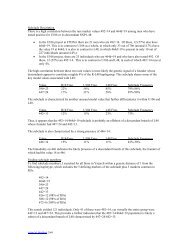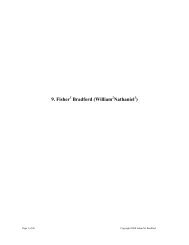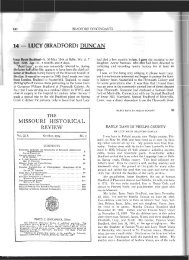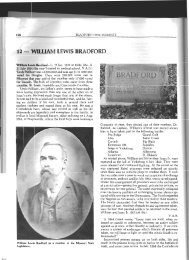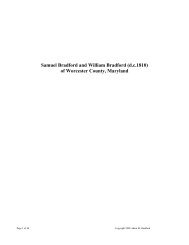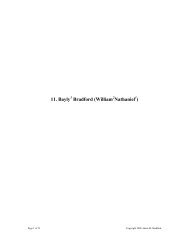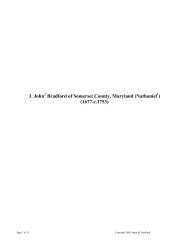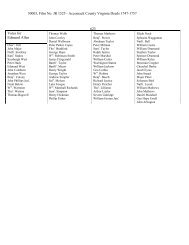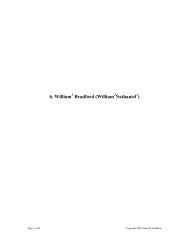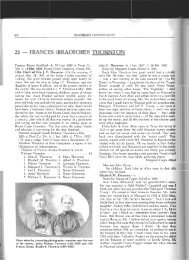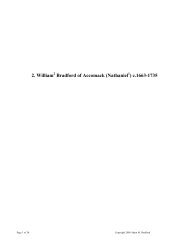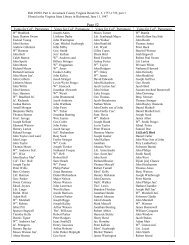1. Nathaniel Bradford of Accomack County, Virginia - Lower ...
1. Nathaniel Bradford of Accomack County, Virginia - Lower ...
1. Nathaniel Bradford of Accomack County, Virginia - Lower ...
Create successful ePaper yourself
Turn your PDF publications into a flip-book with our unique Google optimized e-Paper software.
Settling <strong>Bradford</strong>’s Neck: 1662-1665<br />
On 26 March 1662, for the transportation <strong>of</strong> 20 headrights, <strong>Nathaniel</strong> <strong>Bradford</strong> received a patent for 1000<br />
acres on the eastern banks <strong>of</strong> Matchapungo Creek, near the Indian village <strong>of</strong> Matchapreague 51 . Two years<br />
later, in 1664, he received a patent for an additional 1400 acres north <strong>of</strong> the original 1000, this later portion<br />
being on assignment from Colonel Edmund Scarburgh and for the transportation <strong>of</strong> 28 individuals 52 . In the<br />
meantime <strong>Nathaniel</strong> had sold <strong>of</strong>f his two other tracts, the 400 acres in Northampton in August 1663 53 and in<br />
October 1664 the 500 acres inherited from Richard Smith 54 . The 2400 acres at Matchapungo became<br />
<strong>Nathaniel</strong>’s home plantation and remained almost wholly in the possession <strong>of</strong> his descendants for yet<br />
another century. Portions <strong>of</strong> the land continued in his descendants’ ownership for over a century longer. In<br />
time the entire stretch <strong>of</strong> land came to be called <strong>Bradford</strong>’s Neck, as it is still known to this day. [Note:<br />
Some sources state that <strong>Nathaniel</strong>’s plantation was called Atlantic View, but this is a misunderstanding.<br />
There was a house called Atlantic View that was built much later on the property (probably in the 19 th<br />
century) by the LeCato family, one <strong>of</strong> whom married <strong>Nathaniel</strong>’s great-great-granddaughter. If <strong>Nathaniel</strong><br />
had a name for his plantation, it has not been recorded.] 55<br />
On the same day that <strong>Nathaniel</strong> & Alice sold the land inherited from Richard Smith, <strong>Nathaniel</strong> made a gift<br />
<strong>of</strong> land to his son <strong>Nathaniel</strong> Jr., in order to honor the provision in Richard Smith’s will stipulating that<br />
Alice’s inheritance was to run in the line <strong>of</strong> her children:<br />
“<strong>Nathaniel</strong>l <strong>Bradford</strong>, currier, for considerations accruing to him by the marriage <strong>of</strong> Alice Smith,<br />
daughter <strong>of</strong> Richard Smith, deceased, granted to <strong>Nathaniel</strong>l <strong>Bradford</strong>, Jr., "my heir and the heir <strong>of</strong><br />
the abovesaid Smith," 800 acres, being part <strong>of</strong> the 1400 acres purchased by <strong>Bradford</strong>, Sr. from<br />
Col. Edmond Scarburgh, now the home plantation at Matchapreage. This was given in lieu <strong>of</strong> 500<br />
acres sold by <strong>Bradford</strong> to John Fawsett and Dermon Selevant on the north side <strong>of</strong> the head <strong>of</strong><br />
Occahonnock Creek and formerly belonged to Richard Smith. The conditions: if <strong>Nathaniel</strong>l<br />
<strong>Bradford</strong>, Jr., or the heirs <strong>of</strong> Richard Smith when coming <strong>of</strong> age, trouble John Fawsett or Dermon<br />
Selevant in regards to the possession <strong>of</strong> the 500 acres, then Fawsett and Selevant should possess<br />
the 800 acres. <strong>Bradford</strong> acknowledged receiving 8000 lbs tobacco, and 4 cows and calves from<br />
Fawsett and Selevant. Signed 18 October 1664, <strong>Nathaniel</strong>l <strong>Bradford</strong>. Witnesses: John West and<br />
Ed. Boteler. Recorded 20 October 1664, by Robt. Hutchinson” 56<br />
When <strong>Nathaniel</strong> sold the Richard Smith land to Fawsett and Sellivant, the tract at Matchapreague was<br />
referred to as “now the home plantation.” But even after settling at Matchapungo and selling <strong>of</strong>f his other<br />
land, it appears that <strong>Nathaniel</strong> may have maintained the use <strong>of</strong> the plantation at Occahannock for a time.<br />
Indication <strong>of</strong> this appears in a deposition given by <strong>Nathaniel</strong>’s servant Robert Atkins on 16 June 1665 as<br />
evidence in the suit <strong>of</strong> <strong>Nathaniel</strong> against Alphonsoe Balls for riding <strong>Nathaniel</strong>’s horse without permission:<br />
“Deposition <strong>of</strong> Robert Atkins aged about 21 years: Said that after Alphansoe Balls and the wife <strong>of</strong><br />
Bartholomew Meeres used the horse, she took the horse to the tanner’s old plantation on a Friday<br />
and gave it to Atkins, the tanner’s servant. On Saturday Atkins fetched the horse and carried to his<br />
master’s house at Matchapreage two tables, a grindstone and three hides and then turned the horse<br />
loose in the woods. On the following Friday Atkins was sent down into Matchapungo Neck to<br />
look for the horse, where he found him looking well. His master saw the horse when he got home<br />
and sent Atkins to Occahonnock to his old plantation for hides. After spending the night, Atkins<br />
caught the horse and carried eight hides home. The horse did not falter in the least and ate corn<br />
before being released in the woods. Toward the end <strong>of</strong> the next week, Atkins searched for the<br />
horse and found him dead. Signed, Robt. (O) Atkins.” 57 [Emphasis mine.]<br />
As <strong>Nathaniel</strong> had sold the plantation at Occahannock on 18 October 1664, perhaps the “old plantation”<br />
Atkins refers to is the land inherited by Richard Smith’s other daughter Susan, who wed Robert Richardson<br />
after her father’s death. Robert Richardson, like <strong>Nathaniel</strong>, was engaged in the leather trade. 58 Since<br />
<strong>Nathaniel</strong> and Robert were related it’s not hard to imagine them working with one another in the production<br />
<strong>of</strong> leather and the manufacture <strong>of</strong> shoes. Neither Dermon Sellivant or John Fawsett, to whom <strong>Nathaniel</strong> and<br />
Page 12 <strong>of</strong> 74 Copyright 2008 Adam M. <strong>Bradford</strong>




